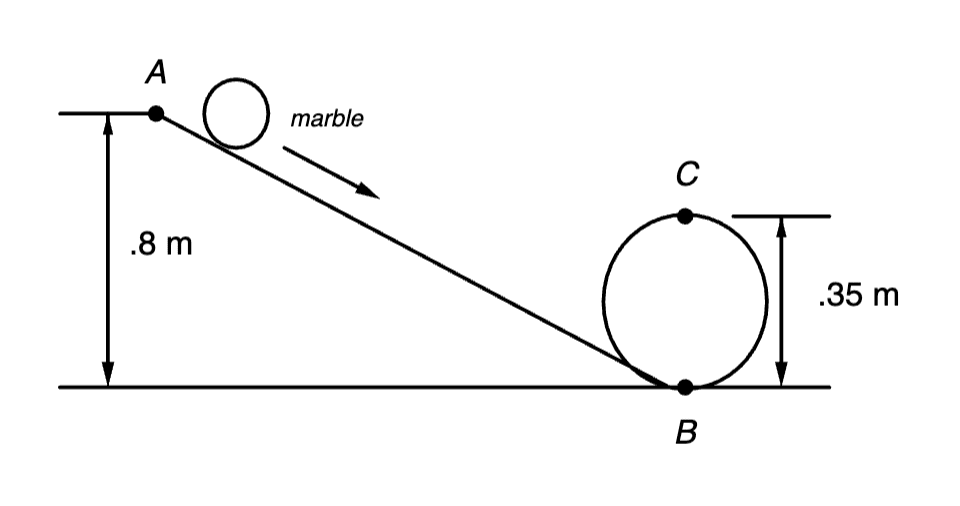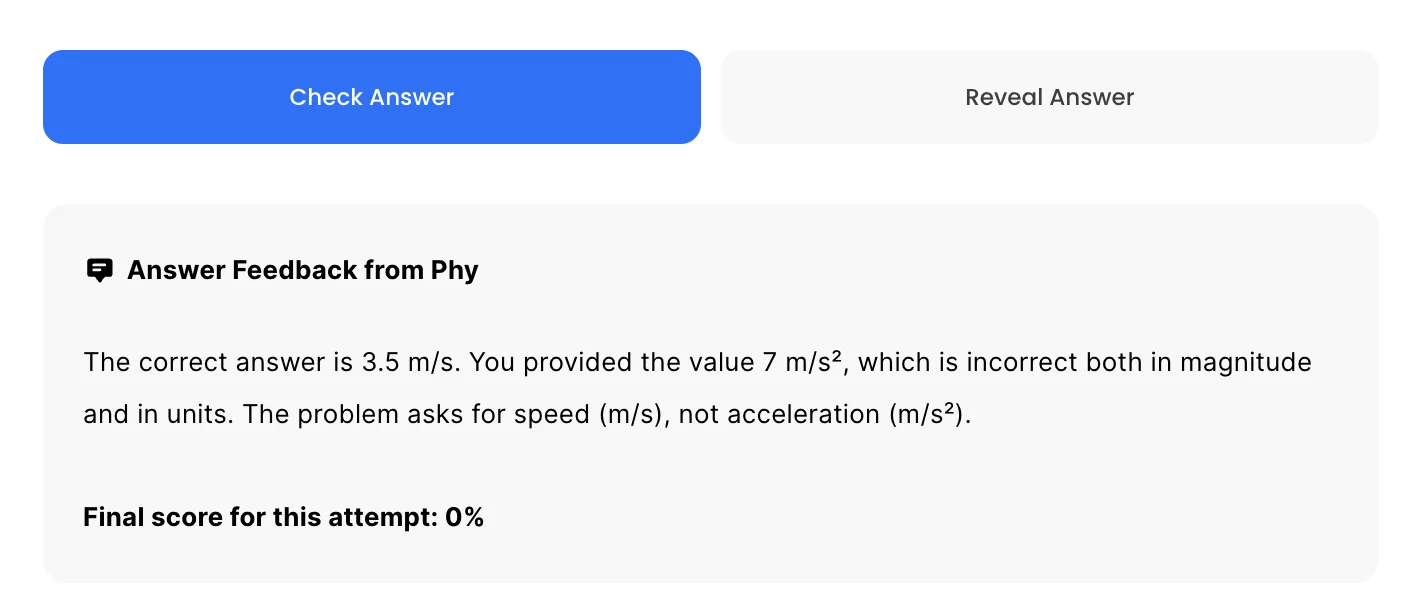# Part (a) Free Body Diagram Explanation
Please visualize or draw out the FBD as described:
– Gravity ( \vec{mg} ): Acts directly downwards. With a mass of m = 90 + 12 = 102 kg.
– Normal Force ( \vec{N} ): Acts perpendicular to the surface of the incline.
– Frictional Force ( \vec{f} ): Acts parallel to the incline against the direction of motion during ascent and in the opposite direction of velocity during descent.
– Component of Gravitational Force down the incline ( \vec{mg} \sin(\theta) ): Helps in descending and resists during ascending. Here \theta = 30^\circ .
# Part (b) Calculation of Work Done by Friction to Stop the Bicycle
| Step | Derivation/Formula | Reasoning |
|---|---|---|
| 1 | F_f = \mu_k N | Frictional force, F_f , is the product of the coefficient of kinetic friction, \mu_k , and the normal force, N . |
| 2 | N = mg \cos(\theta) | Normal force is the component of the gravitational force perpendicular to the incline. |
| 3 | F_f = 0.7 \times 102 \times 9.8 \times \cos(30^\circ) | Calculate F_f using \mu_k = 0.7 , m = 102 kg, g = 9.8 \, \text{m/s}^2 , and \theta = 30^\circ . |
| 4 | W_f = -F_f d | Work done by friction, W_f , is the product of the frictional force and the distance, d , over which it acts, with a negative sign indicating work done against the motion. |
| 5 | W_f = -0.7 \times 102 \times 9.8 \times \cos(30^\circ) \times 9 | Substitute values to calculate the work done. The distance d = 9 m. |
| 6 | W_f \approx -5454 \, \text{J} | Calculated work done by friction; it’s negative as it opposes the direction of motion. |
# Part (c) Explanation – Difficulty of Traveling Up vs. Down the Incline
| Step | Derivation/Formula | Reasoning |
|---|---|---|
| 1 | F_{\text{gravity, down}} = mg \sin(\theta) | Component of gravitational force along the incline that assists in descending and opposes during ascending. |
| 2 | F_{\text{friction, up}} = \mu_s N | Static friction opposing the upward motion, which is higher due to increased force requirements. |
| 3 | F_{\text{net, up}} = F_{\text{gravity, down}} + F_{\text{friction, up}} | Sum of forces opposing the ascent, both the gravitational pull back down the incline and the frictional force. |
| 4 | F_{\text{net, down}} = F_{\text{gravity, down}} – F_{\text{friction, down}} | Net force during descent is reduced because friction (now kinetic) is less than static friction and gravity assists in motion. |
| 5 | Comparison | The cyclist finds it harder to travel up due to higher net opposing force (more friction and gravity opposing motion). |
Phy can also check your working. Just snap a picture!
A car traveling to the right with a speed v brakes to a stop in a distance d. What is the work done on the car by the frictional force F? (Assume that the frictional force is constant)
An object is projected vertically upward from ground level. It rises to a maximum height H . If air resistance is negligible, which of the following must be true for the object when it is at a height H/2 ?
A simple pendulum consists of a sphere tied to the end of a string of negligible mass. The sphere is pulled back until the string is horizontal and then released from rest. Assume the gravitational potential energy is zero when the sphere is at its lowest point.
What angle will the string make with the horizontal when the kinetic energy and the potential energy of the sphere-Earth system are equal?

The diagram above shows a marble rolling down an incline, the bottom part of which has been bent into a loop. The marble is released from point A at a height of 0.80 m above the ground. Point B is the lowest point and point C the highest point of the loop. The diameter of the loop is 0.35 m. The mass of the marble is 0.050 kg. Friction forces and any gain in kinetic energy due to the rotating of the marble can be ignored. When answering the following questions, consider the marble when it is at point C.
Two blocks of ice, one five times as heavy as the other, are at rest on a frozen lake. A person then pushes each block the same distance d. Ignore friction and assume that an equal force F is exerted on each block. Which of the following statements is true about the kinetic energy of the heavier block after the push?
By continuing you (1) agree to our Terms of Sale and Terms of Use and (2) consent to sharing your IP and browser information used by this site’s security protocols as outlined in our Privacy Policy.
| Kinematics | Forces |
|---|---|
| \Delta x = v_i t + \frac{1}{2} at^2 | F = ma |
| v = v_i + at | F_g = \frac{G m_1m_2}{r^2} |
| a = \frac{\Delta v}{\Delta t} | f = \mu N |
| R = \frac{v_i^2 \sin(2\theta)}{g} |
| Circular Motion | Energy |
|---|---|
| F_c = \frac{mv^2}{r} | KE = \frac{1}{2} mv^2 |
| a_c = \frac{v^2}{r} | PE = mgh |
| KE_i + PE_i = KE_f + PE_f |
| Momentum | Torque and Rotations |
|---|---|
| p = m v | \tau = r \cdot F \cdot \sin(\theta) |
| J = \Delta p | I = \sum mr^2 |
| p_i = p_f | L = I \cdot \omega |
| Simple Harmonic Motion |
|---|
| F = -k x |
| T = 2\pi \sqrt{\frac{l}{g}} |
| T = 2\pi \sqrt{\frac{m}{k}} |
| Constant | Description |
|---|---|
| g | Acceleration due to gravity, typically 9.8 , \text{m/s}^2 on Earth’s surface |
| G | Universal Gravitational Constant, 6.674 \times 10^{-11} , \text{N} \cdot \text{m}^2/\text{kg}^2 |
| \mu_k and \mu_s | Coefficients of kinetic (\mu_k) and static (\mu_s) friction, dimensionless. Static friction (\mu_s) is usually greater than kinetic friction (\mu_k) as it resists the start of motion. |
| k | Spring constant, in \text{N/m} |
| M_E = 5.972 \times 10^{24} , \text{kg} | Mass of the Earth |
| M_M = 7.348 \times 10^{22} , \text{kg} | Mass of the Moon |
| M_M = 1.989 \times 10^{30} , \text{kg} | Mass of the Sun |
| Variable | SI Unit |
|---|---|
| s (Displacement) | \text{meters (m)} |
| v (Velocity) | \text{meters per second (m/s)} |
| a (Acceleration) | \text{meters per second squared (m/s}^2\text{)} |
| t (Time) | \text{seconds (s)} |
| m (Mass) | \text{kilograms (kg)} |
| Variable | Derived SI Unit |
|---|---|
| F (Force) | \text{newtons (N)} |
| E, PE, KE (Energy, Potential Energy, Kinetic Energy) | \text{joules (J)} |
| P (Power) | \text{watts (W)} |
| p (Momentum) | \text{kilogram meters per second (kgm/s)} |
| \omega (Angular Velocity) | \text{radians per second (rad/s)} |
| \tau (Torque) | \text{newton meters (Nm)} |
| I (Moment of Inertia) | \text{kilogram meter squared (kgm}^2\text{)} |
| f (Frequency) | \text{hertz (Hz)} |
General Metric Conversion Chart
Example of using unit analysis: Convert 5 kilometers to millimeters.
Start with the given measurement: \text{5 km}
Use the conversion factors for kilometers to meters and meters to millimeters: \text{5 km} \times \frac{10^3 \, \text{m}}{1 \, \text{km}} \times \frac{10^3 \, \text{mm}}{1 \, \text{m}}
Perform the multiplication: \text{5 km} \times \frac{10^3 \, \text{m}}{1 \, \text{km}} \times \frac{10^3 \, \text{mm}}{1 \, \text{m}} = 5 \times 10^3 \times 10^3 \, \text{mm}
Simplify to get the final answer: \boxed{5 \times 10^6 \, \text{mm}}
Prefix | Symbol | Power of Ten | Equivalent |
|---|---|---|---|
Pico- | p | 10^{-12} | 0.000000000001 |
Nano- | n | 10^{-9} | 0.000000001 |
Micro- | µ | 10^{-6} | 0.000001 |
Milli- | m | 10^{-3} | 0.001 |
Centi- | c | 10^{-2} | 0.01 |
Deci- | d | 10^{-1} | 0.1 |
(Base unit) | – | 10^{0} | 1 |
Deca- or Deka- | da | 10^{1} | 10 |
Hecto- | h | 10^{2} | 100 |
Kilo- | k | 10^{3} | 1,000 |
Mega- | M | 10^{6} | 1,000,000 |
Giga- | G | 10^{9} | 1,000,000,000 |
Tera- | T | 10^{12} | 1,000,000,000,000 |
The most advanced version of Phy. Currently 50% off, for early supporters.
per month
Billed Monthly. Cancel Anytime.
Trial –> Phy Pro
A quick explanation
UBQ credits are specifically used to grade your FRQs and GQs.
You can still view questions and see answers without credits.
Submitting an answer counts as 1 attempt.
Seeing answer or explanation counts as a failed attempt.
Lastly, check your average score, across every attempt, in the top left.
MCQs are 1 point each. GQs are 1 point. FRQs will state points for each part.
Phy can give partial credit for GQs & FRQs.
Phy sees everything.
It customizes responses, explanations, and feedback based on what you struggle with. Try your best on every question!
Understand you mistakes quicker.

For GQs and FRQs, Phy provides brief feedback as to how you can improve your answer.
Aim to increase your understadning and average score with every attempt!
10 Free Credits To Get You Started
*Phy Pro members get unlimited credits

By continuing you agree to nerd-notes.com Terms of Service, Privacy Policy, and our usage of user data.